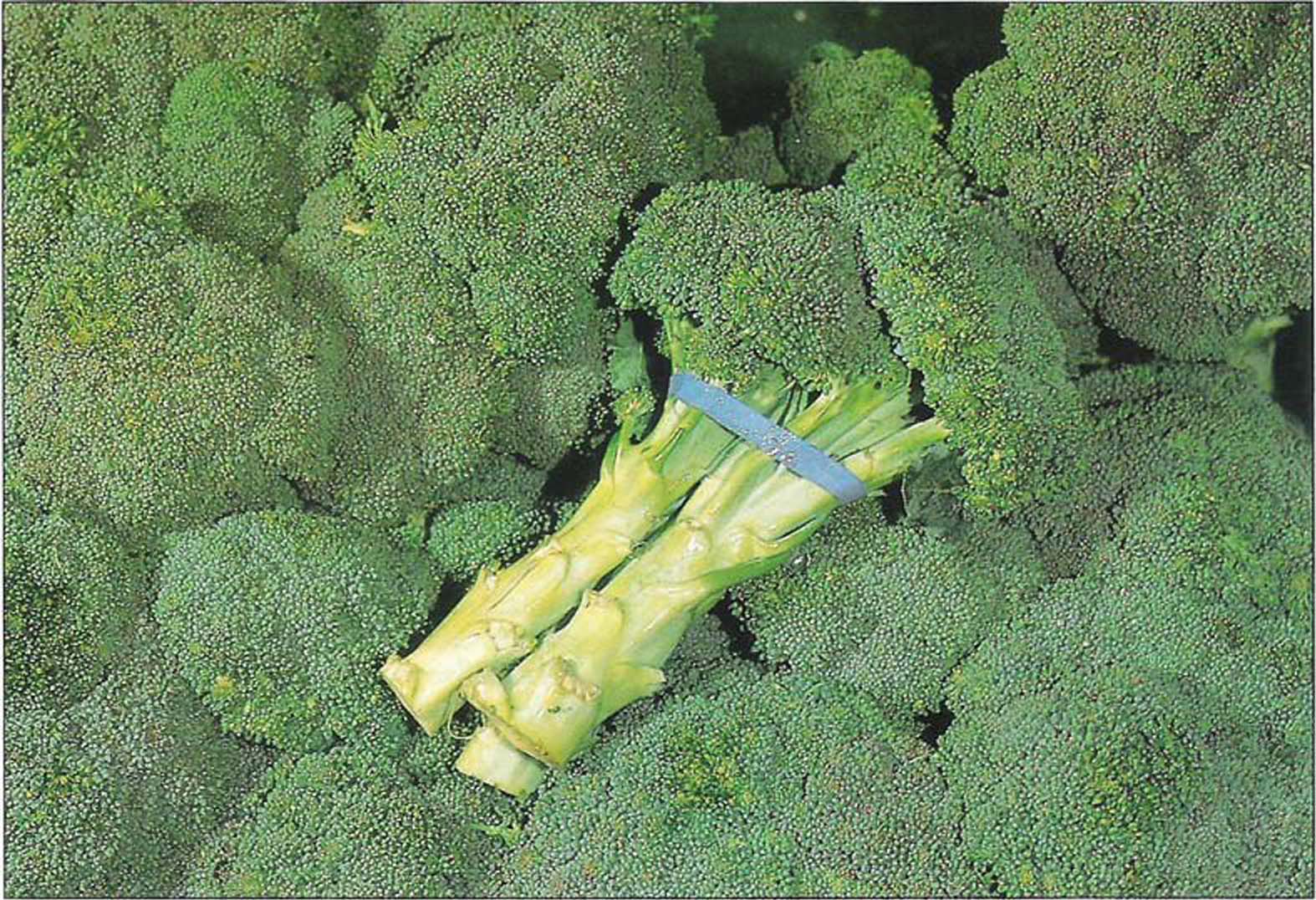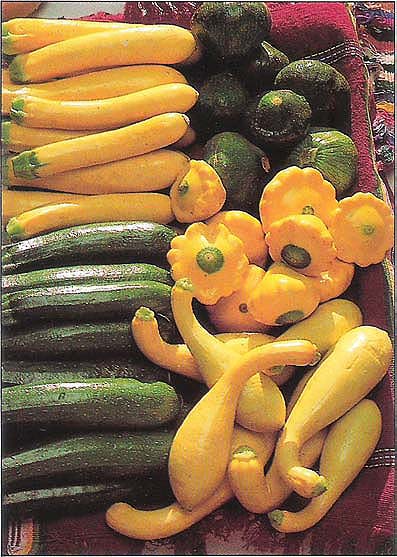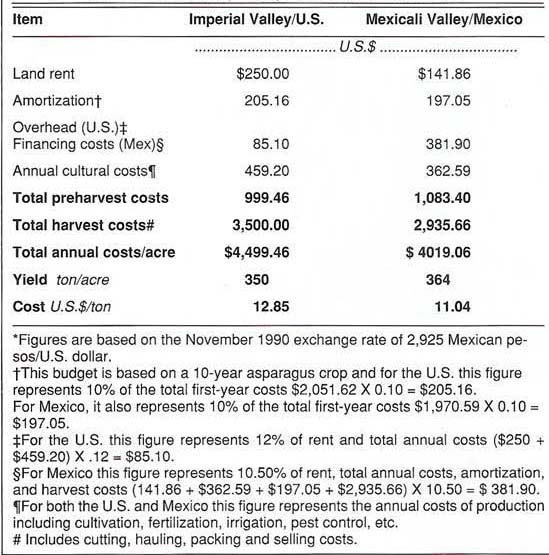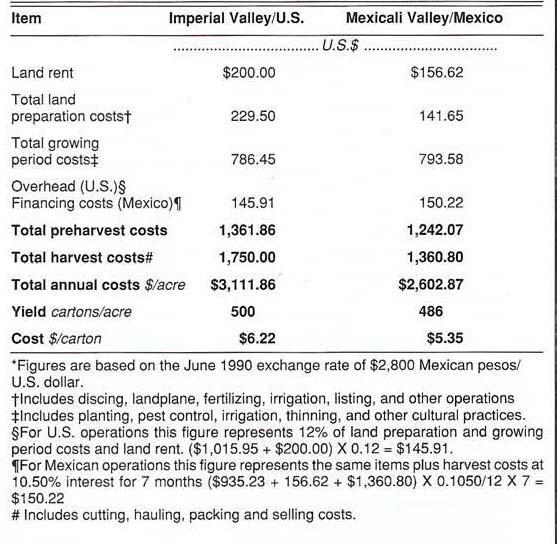All Issues
U.S.-Mexico production costs compared: Asparagus, broccoli production likely to shift to Mexicali
Publication Information
California Agriculture 45(5):21-23.
Published September 01, 1991
PDF | Citation | Permissions
Abstract
Farmers in the Mexicali Valley of Baja California-North growing two specialty crops, asparagus (Asparagus officinalis) and broccoli (Brassica oleracea) hold an economic advantage over farmers growing the same two crops in the Imperial Valley of California. Potential shifts in production from the U.S. to Mexico may have an effect on the number of jobs, the private sales sector, and personal income in Imperial County.
Full text
The proposed North American Free Trade Agreement has caused fear among farmers along the United States-Mexico border regarding possible shifts in the production of specialty crops. Some growers believe that Mexico, with abundant cheap labor, has the comparative advantage and that the production of specialty crops such as asparagus and broccoli will shift away from California to Mexico.
To address this concern, we worked with the Department of Agriculture for the State of Baja California-North and with Fondo de Garantía y Fomento Para La Agricultura, Ganadería, y Avicultura y Fideicomisos Agricolas (FIRA) — a financial institution that guarantees loans made by banks to farmers, to estimate per-acre and per-unit production costs of growing asparagus and broccoli on both sides of the border. Our goal was to establish the comparative costs of production in the two farming communities, those in the Imperial Valley, California and those in the Mexicali Valley, Baja California-North, Mexico. We developed production-cost comparisons and local economic impact scenarios that could be used for discussion and planning purposes by farmers, local legislators, and trade negotiators.
The production shifts expected in broccoli and asparagus may also occur in other specialty crops, including squash.
We selected asparagus and broccoli for this study because these two crops are grown in both valleys on either side of the border. It is important to understand, however, that the free trade agreement may have similar impacts on a broad range of specialty crops.
Methodology
We worked with personnel from FIRA and the Department of Agriculture, Baja California-North to insure that data on Mexicali and Imperial Valley production costs were comparable. Imperial Valley costs appear in the University of California-Imperial County publication 104V, Guidelines to Production Costs and Practices -Vegetable Crops. We selected this crop budget format because publication 104V has a long history of use by farmers and financial institutions on both sides of the border. It was our intent to use a crop budget format that was widely accepted in the region of study, even though it created a shortcoming in the methodology: namely, the number of farmers providing data in Mexicali would be fewer than those providing data in Imperial.
Crop budget data in publication 104V are cost averages derived from approximately 50 contacts made with farmers, fertilizer and chemical vendors, and pest control advisors in the Imperial Valley. In the Mexicali Valley, there are fewer farmers growing asparagus and broccoli. Traditionally, the major crops in that region are cotton and wheat. For this reason, there were fewer sources of data. We obtained information from approximately 15 growers; the information was verified in interviews. With the Mexican production costs converted from pesos to dollars and hectares to acres, we estimated total per-acre and per-unit production costs.
The exchange rate used in cost comparisons was current for the period in question. This rate has changed continuously in recent years; in fact, there has been a different exchange rate every month for more than 5 years (in most cases, the dollar has gotten stronger, but not by equal increments). Since the rate will probably continue to fluctuate in an unpredictable way, we made no attempt to project the effects of a changing exchange rate. Further, we chose not to speculate on how the free trade agreement (FTA) might affect the exchange rate, because it is not clear what this effect might be.
We used an economic input-output model for Imperial County to estimate local economic impacts associated with hypothetical decreases in production of asparagus and broccoli, the model was derived from the U.S. Forest Service IMPLAN system. This is a nationwide computer model capable of generating input-output models for any county in the U.S. These models are widely used in the U.S. for estimating the economic impacts of all kinds of changes.
TABLE 1. Asparagus crop budgets in the Imperial Valley OF California and in the Mexicali Valley of Baja California-North, Mexico*
Results
Asparagus
The cost of production per carton of asparagus in the Imperial Valley is $1.81 more than that of the Mexicali Valley — $12.85 and $11.04 respectively, based on a yield of 350 cartons per acre in the Imperial Valley and a yield of 364 cartons per acre in the Mexicali Valley. The per-acre cost of growing asparagus in the Imperial Valley is $480.40, greater that the per-acre cost of growing asparagus in the Mexicali Valley (table 1). Total per-acre asparagus production costs in the Imperial Valley and in the Mexicali Valley are $4,499.46 and $4,019.06, respectively. Harvest costs in the Imperial Valley are $1,935 greater per carton than in the Mexicali Valley. The per-carton harvest costs for both sets of producers include costs for cutting, hauling, packing, and selling. For the Mexicali Valley farmer, it also includes the export tariff.
TABLE 2. Broccoli crop budgets in the Imperial Valley California, and in the Mexicali Valley of Baja California-North, Mexico*
Broccoli
The cost of production per carton of broccoli in the Imperial Valley is $0.87 greater than that of the Mexicali Valley — $6.22 and $5.35 respectively, based on a yield of 500 cartons per acre in the Imperial Valley and 486 cartons per acre in the Mexicali Valley. The per-acre cost of growing broccoli in the Imperial Valley is $508.99, greater than the per-acre costs of growing broccoli in the Mexicali Valley (table 2). Total per-acre broccoli production costs in the Imperial Valley and in the Mexicali Valley are $3,111.86 and $2,602.87 respectively. Harvest costs in the Imperial Valley are $0.70 greater per carton than in the Mexicali Valley. The per-carton harvest costs for both sets of producers includes the costs for custom harvest, pack, haul and sell. For the Mexicali Valley farmer, it also includes the export tariff.
Observations
The daily wage rate for 8 hours of labor in Mexico is approximately $10/day. In the U.S., farmers may pay between $4.25/hr and $5.50/hr. This gives the Mexicali farmer a clear competitive advantage with regard to labor costs. We do not know how new technologies in the U.S. might shrink this advantage, and therefore did not include possible scenarios.
With these magnitudes of cost-of-production differences, we don't actually know what decreases in production will occur in Imperial County. For demonstration purposes, we have chosen the modest decreases of 10, 20, and 30% of 1990 production levels, although the actual decreases may be higher, based on the trade negotiations and the time period under consideration. It is not inconceivable that if these cost-of-production differences remain, all broccoli and asparagus production will vanish from the Imperial Valley. These decreases will have ripple or multiplier effects in the county. The input-output model is used to estimate these effects.
Three kinds of economic impacts are shown in the table. All of the impacts are yearly amounts. “Total sales” is the impact on private sector sales in the county. “Personal income” is the impact on income in the county. “Jobs” is the decrease in jobs in the county.
In estimating the economic impacts of the decreases in production, we have not calculated the positive effects of substitute activities using the resources (such as land and labor) made available by a decrease in production. Also, we have not calculated the economic effects of a possible change in broccoli or asparagus technology, brought on by the changing economics of the situation. Therefore, these estimates are rough and may overestimate the impacts on Imperial County.
To put these economic impacts in some kind of perspective, if a 30% decrease in production occurred for both broccoli and asparagus, the decrease in Imperial County's personal income would be about 1% of the 1989 total. The model also predicts 395 jobs would be lost. (Because the model is linear, it predicts that a 90% decrease in both broccoli and asparagus production would lead to a 3% drop in the county's total personal income, and the loss of 1,185 jobs.)
Discussion
A small number of farmers of specialty crops in the Imperial Valley also farm in the Mexicali Valley. The economic advantage of growing asparagus and broccoli in the Mexicali Valley has existed in the past and a lowering of the export tariff as a result of a free trade agreement will enhance that advantage. In discussion with a number of Imperial Valley farmers, reasons given for not shifting operations to Mexico include: Mexico's land reform laws may not allow purchase of the most desirable farm land; it may be difficult to arrange joint ventures with a trustworthy Mexican partner; there may be a risk of losing equipment and other property as a result of government intervention. These concerns and fears may be based on events or conditions that occurred or existed in the past. Although changes have been made by the Mexican government to attract more foreign investment, some farmers in the Imperial Valley remain reluctant to risk starting or shifting operations to the Mexicali Valley.
TABLE 3. Negative economic impacts of a decrease in asparagus and broccoli production in Imperial County, based on 1990 production costs*
Those farmers currently growing asparagus and broccoli in the Mexicali Valley enjoy lower production costs and will profit even more if the tariff on these commodities is significantly reduced or eliminated. Farmers in the Imperial Valley fear that the elimination or rapid reduction of current tariffs will result in increased imports of the two crops. They believe the resulting oversupply would depress prices, lower profits and cause economic losses. These farmers strongly support gradual lowering of tariffs — perhaps over a 20-year period — with “snapback” provisions. A snapback provision would trigger a return to current tariff levels when Mexican imports begin to flood the market.
Conclusion
The study provides a comparison of production costs associated with two specialty crops asparagus and broccoli, grown in the Imperial Valley, California and in the Mexicali Valley, Baja California-North, Mexico. Given that Mexicali farmers growing asparagus and broccoli have a comparative advantage, we may assume that there might be a decrease in the production of these two speciality crops in the Imperial Valley.
If the Imperial Valley should lose 30% of the production of both asparagus and broccoli the county stands to lose approximately 1% of personal income and 395 jobs. It may be that many of the persons that could become unemployed live in Mexicali. However, the “lost jobs” are in the Imperial Valley and it is most likely that those workers will collect unemployment benefits in Imperial County.
This study can provide valuable information to farmers who grow these two speciality crops as well as to local legislators interested on the impacts of possible production shifts. It can also be a useful tool for persons serving on both the U.S. and Mexico FTA negotiating teams.









